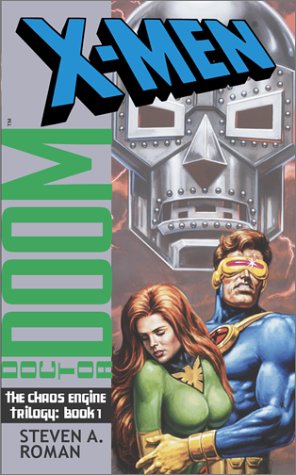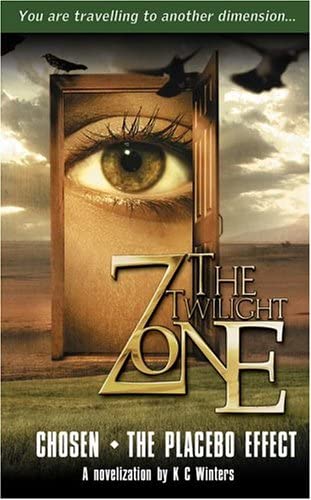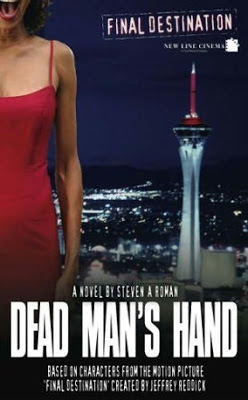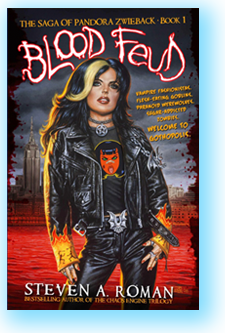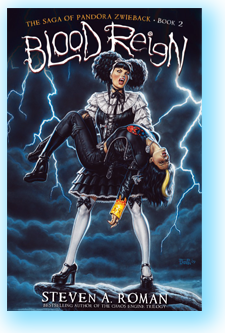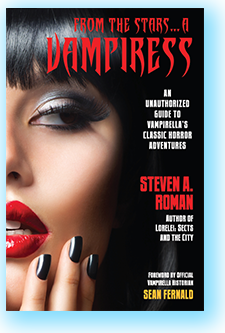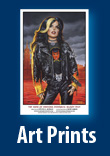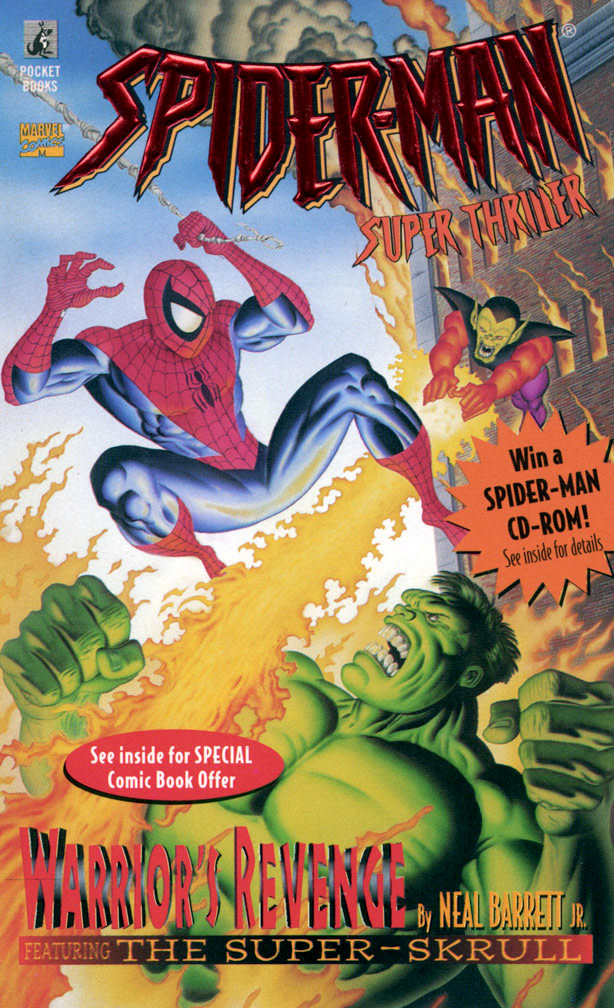
Spider-Man Super Thriller: Warrior’s Revenge. If the Amazon listing for the book’s publication date is correct (and really, I have no way of knowing if it’s true or not), today is the day in 1997 that I made my debut as a novelist—twenty-five years ago! Where did the time go?
A young adult novel in which the Amazing Spider-Man teams up with the Incredible Hulk to fight the Super-Skrull, a shape-shifting bad guy from the Fantastic Four comics, it was a manuscript I cranked out in a fairly short amount of time (you’ll find out why as you read on) and found immediate approval from Marvel Comics. Sure, when it hit bookstores in August ’97 not everyone has loved it, but as the old saying goes, you take the good with the bad.
The site SpiderFan.org, for instance, gave it a two-Spidey rating, but they did find some enjoyment in its pages: “The story won’t win a Booker [Award], but in general I have to say that the writing is actually pretty good. Barrett coins a nice phrase, and while he flirts with cliché, he doesn’t get down and dirty with it.”
A reviewer at Goodreads, on the other hand, outright hated it: “Neal Barrett, Jr. shows real craftsmanship except when it comes to quiet moments of conversation between friends. That dialogue is smarmy and has many forced references to what good friends these characters are.”
However, at Amazon U.S., one reader called it “the best book in the [Super Thrillers] series,” while another complained about it being a “children’s book” with a short page count (it’s 144 pages). The most encouraging response came from a reader at Amazon U.K.: “Neal Barrett did an awesome job writing this book! I know the author has inspired me a great deal. I would someday like to follow in his footsteps and become an author along with a doctor!”
Of course, what none of these folks—and probably every other reader of the book—knew is that Neal Barrett Jr. didn’t write Warrior’s Revenge. I did.
It goes like this: In 1996, Byron Preiss, the publisher for whom I worked as an editor, had two major licenses with Marvel Comics: one to do novels and anthologies for an adult audience, that were co-published by Byron Preiss Multimedia Company and Berkley Books; and one to do books for middle-grade (ages 8–12) readers that were co-published by BPMC and Simon & Schuster’s Pocket Books imprint.
The latter series—for which I served as editor—was comprised of eight books, was called “Super Thrillers,” and starred Spidey in seven of them (including a pair of You Are Spider-Man Choose-Your-Own-Adventure-style entries), plus one Iron Man adventure. The writers involved were science-fiction writer James D. Macdonald (using the pseudonym Martin Delrio), Star Trek and Stargate author Bill McCay, Dean Wesley Smith, pop-culture writer Richie Chevat, and Neal Barrett Jr. Cover art was provided by the team of Mike Zeck (pencils) and Phil Zimelman (airbushed painting), as well as by Ernie Colon. Ernie also provided interior spot illustrations for the series, as did Steve Geiger (Web of Spider-Man, and later my SWC graphic novel Lorelei: Sects and the City), John Nyberg, James Fry, Neil Vokes (Tom Holland’s Fright Night—and also Lorelei: Sects and the City) with Michael Avon Oeming (Powers), and Louis Small Jr. (Vampirella) with Ralph Reese (Creepy).
Neal Barrett Jr. was mainly known as an award-winning mystery writer and fantasist (he later achieved the top-level Writer Emeritus status at the Science Fiction Writers of America), but on the side he wrote movie novelizations, including the ones for Dungeons & Dragons: The Movie, Sylvester Stallone’s Judge Dredd, and Pamela Anderson’s Barb Wire—the latter a movie so awful (a terrible knockoff of the Humphrey Bogart-Ingrid Bergman classic Casablanca) the novelization was never published in the U.S. So when we approached him for the series he was very interested, and after the usual editorial back-and-forth over the plot for his first book, he turned in the manuscript for Spider-Man Super Thriller: Lizard’s Rage, in which Spidey fights not just his old enemy The Lizard, but Morbius the Living Vampire as well. I thought it was great, Marvel loved it, and the book went to press.
But when it came time for his next contribution, things didn’t work out so well.
I can’t remember the reasons for it, but Marvel outright rejected his manuscript for Warrior’s Revenge. They didn’t want the manuscript revised, they wanted it dropped completely and the process restarted from scratch with a new plot.
Neal, however, wasn’t interested in doing it—after all, Marvel had approved his plot before he ever started writing the book, so what was this give-us-a-new-plot business? And having already completed the first-draft manuscript, while he would have made revisions based on their feedback, writing a whole new book was out of the question, especially at the low author rates BPMC was paying. I didn’t argue with him—he was right on both counts.
I went in to Byron’s office and explained the situation. He sighed, paused, and then said:
“So, do you want to write it?”
See, Byron knew I was a writer. I was still publishing my first run of Lorelei comics while I was working for him, and I’d previously co-written with Ken Grobe “The Ballad of Fancy Dan,” a short story for an Untold Tales of Spider-Man anthology that was part of the adult-books line. Now he was offering me the opportunity to step up to the next level—but only because I was literally standing right in front of him, so he didn’t have to go searching for Neal’s replacement. I didn’t take that personally, though.
Well, who was I to say no? A paying gig, writing my all-time-favorite comic character? My very first novel?
Of course I said yes.
With the main characters locked in place when Neal started—Spidey, the Hulk, the shape-shifting alien Super-Skrull from the Fantastic Four comics—I churned out the new plot pretty fast. The Hulk, who at that time in Marvel continuity had the brawn of the monster but the brain of his alter ego, Bruce Banner, would be in New York City to watch over an old friend targeted by the Super-Skrull. Spidey gets involved when he comes upon what seems to be a rampaging Hulk chasing a little old lady through Times Square. Once the Skrull-masquerading-as-old-lady situation is explained, Spidey and the Hulk team-up to fight the bad guy. Pretty standard superhero storytelling. So what would be the hook that made it interesting?
“Harlan Ellison is a Skrull, and the Super-Skrull is out to kill him!” is how I pitched my idea to Marvel’s licensing division, which oversaw Byron’s publishing licenses. Of course, it couldn’t be the real Ellison, the legendary, award-winning writer whose most famous mainstream contribution had been the classic Star Trek episode “The City on the Edge of Forever”—as famous as he was for his writing, Harlan was equally famous (or rather infamous) for the lawsuits he’d file when someone did him wrong. So, it would be an Ellison-like author the Super-Skrull was pursuing. (Although, honestly, Harlan the comics geek might’ve gotten a kick out of the notion if we’d told him.) They laughed and instantly said, “Go for it!”
About three months later, I handed in the first-draft manuscript. It went through edits from my editor (and immediate boss) Howard Zimmerman, I made revisions, and we submitted it to Marvel for approval.
They loved it. Some editorial tweaks were offered, and everyone agreed the tone of the story and writing made it more of a “young adult” (12–16 years) novel than the previous middle-grade books in the program, but overall they judged the manuscript good to go. Even better, Neal was cool about the whole situation—at least where I was concerned, having gone from his editor to his replacement. Being a true professional, he sent me a note explaining he had no ill feelings toward me and wished me success.
I was now officially a first-time novelist! There was just one problem…
“We’ve already printed the covers for the entire run,” Byron told me, “with Neal’s name on them. So you’ll have to write it anonymously because we’re not going back to press to fix it. Sorry.”
And thus a legend was born—anonymously, of course.
Since then, I’ve gone on to write a few other novels (as well as a scattering of comic books, graphic novels, short stories, and a nonfiction comics history):
X-Men: The Chaos Engine Trilogy was my follow-up project to Warrior’s Revenge—and another “you want to write it?” assignment when the original author backed out. Three densely packed, original novels that were published from 2000 to 2002 by Byron’s BP Books imprint, they involved the X-Men—particularly the psychic ninja Psylocke—dealing with the repercussions of three major villains controlling the reality-bending device known as the Cosmic Cube (if you’re a fan of Marvel’s movies, you’d know it better as the Tesseract). If you’ve ever wondered what the Marvel Universe would be like under the control of first Doctor Doom (arch-enemy of the Fantastic Four), then Magneto (the X-Men’s #1 bad guy), and finally the Red Skull (Captain America’s favorite Nazi to punch in the face), track down copies of these long-out-of-print books and see how I handled it. X-fans really seemed to enjoy them.
The Twilight Zone: Chosen/The Placebo Effect, published in 2005 by RPG company Games Workshop’s Black Library imprint, was my first (and so far only) venture into the world of licensed novelizations, adapting two scripts from the early 2000s one-season iteration of the Rod Serling–created TV show, this one with actor Forest Whitaker (Species, Ghost Dog, Rogue One: A Star Wars Story) serving as host. Under the pseudonym K.C. Winters—which, yes, means SWC’s in-house “editor” is really yours truly—I expanded the scripts for Ira Steven Behr’s “Chosen” (starring Jake Busey) and Brent V. Friedman’s “The Placebo Effect” (starring Sydney Tamiia Poitier and Star Trek’s Jeffrey Combs) into the 90,000-word length mandated by license owner New Line Cinema; trust me, there was a lot of world-building and characterization that I had to create on the fly to pad out that word count. Working on Twilight Zone, though, led to my next novel:
Final Destination: Dead Man’s Hand, also published in 2005 by the Black Library, was an original novel based on the popular New Line Cinema movie franchise. Set in Las Vegas, Nevada, Dead Man’s Hand is about a group of strangers who narrowly avoid being caught in a major disaster involving an elevator—but since they’d all been destined to die in that accident, the specter of Death literally hunts them down to kill them and balance out his ledger. Following the movies’ formula, those deaths usually involve each character caught in some complicated series of events that borders on the comical—until that character is dispatched in the most gruesome way possible.
As for my effort, some fans enjoyed it, while others found it too slow and talky. Well, as I explained to my editor when I handed in the manuscript, if you want a 90,000-word manuscript, you better expect a lot of characterization to fill the gap between murders. That hefty use of characterization, however, is the reason why I was never given another opportunity to write for Black Library, although I’d submitted pitches for their Friday the 13th and Nightmare on Elm Street book series, as well as for another Final Destination: I was told my ideas were too intellectual for the gore market.
On the other hand, The Saga of Pandora Zwieback is a pair (so far) of young adult dark-urban-fantasy books starring a 16-year-old Goth girl from Queens, NY, who fights monsters alongside friends, family, and an immortal, shapeshifting huntress. Published through StarWarp Concepts, Pan’s prose story consist of a three-part vampire war—Book 1: Blood Feud, Book 2: Blood Reign, and the upcoming Book 3: Blood & Iron—available from online retailers as well as the SWC webstore. Her adventures received quite a bit of acclaim from reviewers, so maybe my “intellectual” approach to character-driven horror isn’t such a turn-off as some would believe…
And although it’s not a novel, From the Stars…a Vampiress: An Unauthorized Guide to Vampirella’s Classic Horror Adventures is a nonfiction history of Vampirella that takes an extensive look at her early days, from the debut of her series in 1969 to the death of Warren Publishing in 1983. In addition to telling the tale of Hammer’s unproduced film adaptation that was to star Barbara Leigh and Peter Cushing, I provide an in-depth guide to all her Warren stories; a checklist of all her Warren appearances (plus the publications from Harris Comics and Dynamite Entertainment that reprinted her Warren adventures); an overview of the six novelizations by pulp sci-fi author Ron Goulart that were published in the 1970s by Warner Books; and a look at the awful 1996 direct-to-cable-TV movie that was made, starring Talisa Soto and Roger Daltrey. There’s also a peek at Mr. Cushing’s personal copy of the ’70s Vampirella screenplay; a foreword by Official Vampirella Historian Sean Fernald, a frontispiece by Warren artist Bob Larkin, and photographs from the personal archives of Forrest J Ackerman.
So, what’s next for this novelist? I’ll let you know when I find out!

